by Winding Pathways | Sep 22, 2022 | (Sub)Urban Homesteading, Amphibians/Reptiles, Birds, Garden/Yard, Nature
We hadn’t seen either for a while but one September morning there they were. Mr. Toad and Ms. Wren.
Mr. Toad
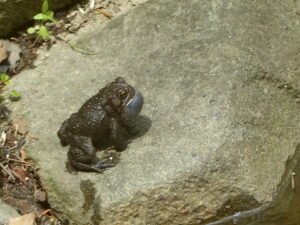
Toads sing loudly day and night.
All summer Mr. Toad contentedly lived beneath a tomato plant snacking on an occasional juicy bug. Ms. Wren meanwhile forayed about the yard snatching bugs and feeding her brood. In September Mr. Toad’s favorite tomato plant died back, probably tired after producing plenty of tasty fruits and no longer able to give Mr. Toad a worthy hiding place. And, after the babies fledged, Ms. Wren worked the prairie grasses and woods.
On that September morning, Rich noticed sweet potato leaves trembling a bit. He brushed aside the foliage and there was Mr. Toad out seeking breakfast.
The fall equinox is almost here. With it comes the short days and cool temperatures that make garden plants shrink. Mr. Toad is cold-blooded. Summer’s moist heat is to his liking, but before the cold comes, he must retire for the winter. So, down he goes, digging into the soil to find a place to snooze through the winter, no doubt dreaming about next summer’s juicy bugs under a new tomato plant.
We bid Mr. Toad adieu for the winter and said, “Thanks for helping with our gardening. See you next spring.”
Ms. Wren
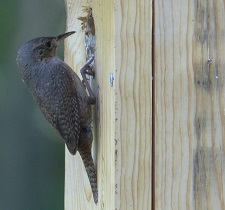
Checking the nest box.
Mr. Toad isn’t our only garden worker. Last winter we set up a wren house and by May Ms. Wren and her partner moved in. The couple raised two broods of ravenous babies in our garden. They enjoy the same fare as Mr. Toad but hunt more in our crop’s leaves instead of under them. The industrious parents spend nearly every daylight hour combing the garden and beyond for insects to feed their chicks.
Our last brood of garden wrens fledged in mid-August but stuck around a while. The family hunts insects in the woods behind the house but by the fall equinox they’ll get the urge to hop on a north wind some night and head south. When we’re shoveling snow, they’ll be snacking on bugs in a warm place.
Parting is Sweet Sorrow When Mr. Toad and Ms. Wren Bid Us Adieu
It’s hard to tell exactly when our wrens leave. Sometimes they linger into October but eventually one of us will say, “I haven’t seen or heard a wren for a while.” Yup, they’ve left for the season. We also bid them adieu and say, “Come back. See you next spring.” We miss Mr. Toad and Ms. Wren for the good work they do and for knowing we provide safe homes for them. We will put up wren boxes come March of next year and search for Mr. Toad sometime when the ground thaws.
About the Equinox
The Fall (autumnal) equinox is on or near September 21st. It’s one of two days when the sun crosses the celestial equator and every place on earth receives approximately 12 hours of daylight and 12 hours of darkness. The other is around March 21, the Vernal equinox. After the fall equinox the dark hours push daylight away until December 21 when days again begin to lengthen in the Northern Hemisphere. Plants and animals are super sensitive to day length and more aware of slight changes than most people.
by Winding Pathways | Mar 25, 2021 | Amphibians/Reptiles, Birds, Bugs, Nature, Trees, Wonderment
Quilting and the Chesapeake Bay
Guest Blogger, Sigrid Reynolds
I have always loved the humble arts of unknown women who pieced quilts. My own attempts at the craft had resulted in exactly 10 squares in the 1980s when I had small children at home who took afternoon naps. At the same time, I started looking through the piles of quilts at antique stores in the Shenandoah Valley. It thrilled me to see the patterns, colors, and precise stitching of women from the past. So seduced was I by these piles, I knew collecting could get out of control. But then I found a Pennsylvania Dutch unquilted top in an original bold tulip design of blue, red, and yellow colors. I decided to seek and purchase only this color combination. That kept the lid on it since these colors are rare in combination.
COVID-19 Quilting
Taking up quilting again didn’t occur to me until Spring 2020 when I was asked to join a young friend’s virtual pandemic quilt circle. In a time when we all faced our own mortality and the uncertain path the pandemic and the nation would take, we needed something to calm ourselves. As a retired person, I had nothing filling my time and frankly, felt the need to leave some little part of me behind in the lives of my descendants.
The group chose a striking geometric pattern with many triangular pieces. I purchased material, cut a few triangles, and then I went rogue. My inclination was to go faster, larger and more personal since I’d found piecing tedious in those earlier tries. Besides, I am 30 years older than the members in my group so my “life” time is more limited. I found purpose in a multi-generational family vacation home on the Chesapeake Bay just begging for Aunt Sig artifacts for posterity.
A “Fishy” Quilting Inspiration
My first quilt was a re-interpretation of a fish painting that the family had owned for 90 years. The family has always asked guests to tell them how many fish they see in the painting. So, I added goldfish for a humorous twist and quilted in additional fish. In all, there are 40 fish in this quilt.
-
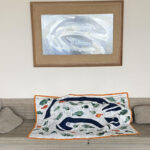
-
A humorous adaptation of the family fish painting.
-
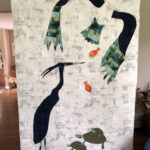
-
Remembering sunning turtles.
What came next was an urge to recognize the other birds and animals seen regularly on or near the Bay: herons in the morning and evening along with osprey all day. And then I was remembering sunning turtles in a nearby spring-fed pond. I added more goldfish and quilt fish to keep the puzzle going.
I next needed to represent the loblolly pines that line the shores of that estuary. And, of course, I needed additional visitors: raccoons, foxes, and box turtles. While quilting, I added one ghostly possum in the lower right-hand corner. And why not add some quilted poison ivy since that is always an island hazard? And yes, there are fish quilted into the water to count.
-
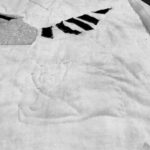
-
The beginnings of a personal quilt.
-
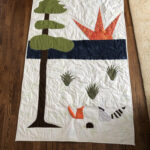
-
Capturing the sunrise
New Inspirations
Finally, as this quiet, worrisome time comes to an end, I realized that I needed to turn from nature to hail the Baltimore Light, a caisson lighthouse, that has defined the deep channel for ships going into Baltimore Harbor my entire life. Since it was winter, I recalled the two times that I had seen the Bay had frozen and decided that might be a good subject. And yes, there will be quilted fish to count under the ice floes.
Nature Continues to Inspire
I have pondered what prompts this late-in-life creativity and conclude that the pandemic opened up a fertile field in me that might have remained fallow. I, like many, turned to the nearby nature of our backyard and parks but memories of a barefoot childhood on the Bay persisted. Quilting allowed me to visit the nature of my memories.


by Winding Pathways | Aug 20, 2020 | (Sub)Urban Homesteading, Amphibians/Reptiles, Garden/Yard, Nature
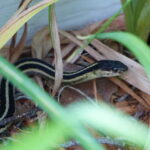
The garter snake lounges in the shade of the cool garden eating insects and worms.
On a July evening, Rich reached down to pick string beans and was startled to spot a garter snake peering up at him from beneath a plant. We’ve seen the three-foot-long snake many times this year around the yard but it seems to particularly like lounging in shade cast by bean plants.
We’re used to snakes, have no particular fear of them, and appreciate their benefits. It’s helpful that no poisonous snakes live in our area. Yet, it’s startling to see one inches from our fingers. “Our” garter snake practices social distancing and is probably more alarmed than we are with an encounter. He or she quickly vacates, letting us pick beans and tomatoes without its company.
What Do Garter Snakes Eat?
Garter snakes are common across the United States and range north into Canada. Constrictors wrap their bodies around a hapless mouse or chipmunk to eventually dispatch it. Garter snakes use a different strategy. They’re versatile carnivores and enjoy dining on insects, worms, slugs, and just about any other small enough animal to fit in their petite mouths. They quickly grab small prey and swallow whole and alive.
How Do Garter Snakes Help in the Yard?
We like our garter snake because of what it represents. If we’d doused the garden with toxic spray to kill insects, we would have no snake. Its presence signifies a healthy yard. Although garter snakes eat both beneficial and harmful insects, they probably devour many more of the latter. And, our compost-rich soil produces an abundance of worms, so the snakes can have all they want. Plenty will survive to aerate the soil.
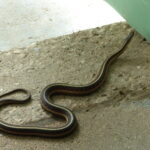
This garter snake was seeking cool shade on a hot summer day.
Startling as our snake may be, it’s as beautiful as a goldfinch or bluebird. Spotting it gives us a moment of joy. After we are done being startled.
- If having a garter snake around really troubles you, Iowa State University Extention has non-lethal ways to reduce the appeal of your yard.
by Winding Pathways | Jul 19, 2018 | (Sub)Urban Homesteading, Amphibians/Reptiles, Birds, Garden/Yard, Mammals, Nature
Susan Hrobar
guest blogger
Fun Through the Window
We are fortunate to live at the end of a channel on a small lake. Our north facing windows face our backyard and the channel. One of our friends, who knows very little about nature, does not understand that after living here for 18 years, we still get excited when we see any wildlife in our yard and in the channel. Most of my photos are taken from windows inside the house, hoping to not spook my photo subjects. We frequently have deer coming through and we can tell which paths are being worn into the ground. During the winter we’ve taken photos of deer amidst the falling snowflakes. And, on our trail cam, we have “caught” coyotes, fox, raccoons, opossums, and neighborhood kitties.
Tom Turkey
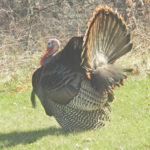
Strutting
This spring we have had a special bonus of occasionally watching a male turkey strut between our and the neighbors’ yards. Usually, he is skittish and if he spots me looking out a window, he quickly moves out of sight. One morning he must have felt like he was “king of the hill” and actually posed for photos about 20 feet from where I was watching him. I have also watched him fly over the channel near dusk and find a tree to roost in for the night. It always amazes me to watch these big birds fly through the trees, as normally you only see them walking and running on the ground.
Turtle Habitat
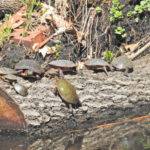
Lounging on a log
Last summer when the water level was high, an oak tree uprooted and fell into the channel, covering both sides of the channel, and completely blocking our water access to the main lake. Because the channel is narrow, there is little clear land on either side. The oak landed at the bottom of a steep hill, so removing it was quite a process. It took a bucket truck on top of the hill, a small boat in the channel, lots of ropes, and a very talented arborist to take care of the problem. This spring the water is lower and that downed tree is now a horizontal stump about four feet long partially submerged from where it fell.
The turtles love this new sunning perch! We have never seen so many turtles at one time. So far, our biggest count has been nine painted turtles on the log. In spring we sometimes get lucky to see a large soft-shell turtle swimming in the channel and climbing out onto the shore. The females are much larger than the males.
Wood Duck- Goose Dustoff
On a recent rainy day, we spotted a pair of wood ducks. They are also very skittish and do not like to pose for photos. We watched as they flew up into a large basswood tree and perched on the branch. I think that is the first time I have ever seen ducks sitting in the trees. It was not a great day for photos, but I tried anyway.
The ducks flew to another tree, rested for a while, and then flew down to the water. Mr. Wood Duck and Mr. (Canada) Goose then had an altercation on the grass with much hissing, honking, flapping of wings, and chasing.
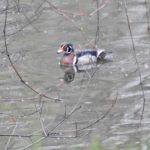
Male wood duck
Mr. Wood Duck was very proud of himself for chasing the goose parents and two goslings of out “his” channel. Mrs. Wood Duck cheered him on while sitting on top of our boat motor. My husband, John, had the fun of watching the goose and duck stand-off. I was trying to get to a different window without all the raindrops obscuring my view. That did not work, but it made me smile to hear John laughing and enjoying the whole spectacle.
Loving Our Wildlife
Even after nearly two decades, we still so enjoy our yard and sharing our stories about animals and plants.
-
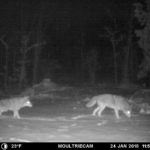
-
Night activity
-
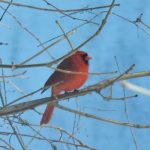
-
Male Cardinal in a tree.
-
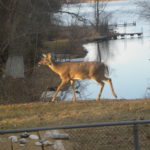
-
Deer in yard.
-
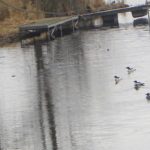
-
Swimming
-
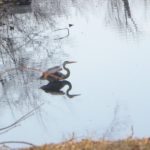
-
A heron spreads its wings
-
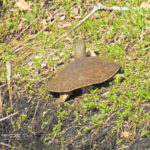
-
Female soft shells are larger than the male.

















